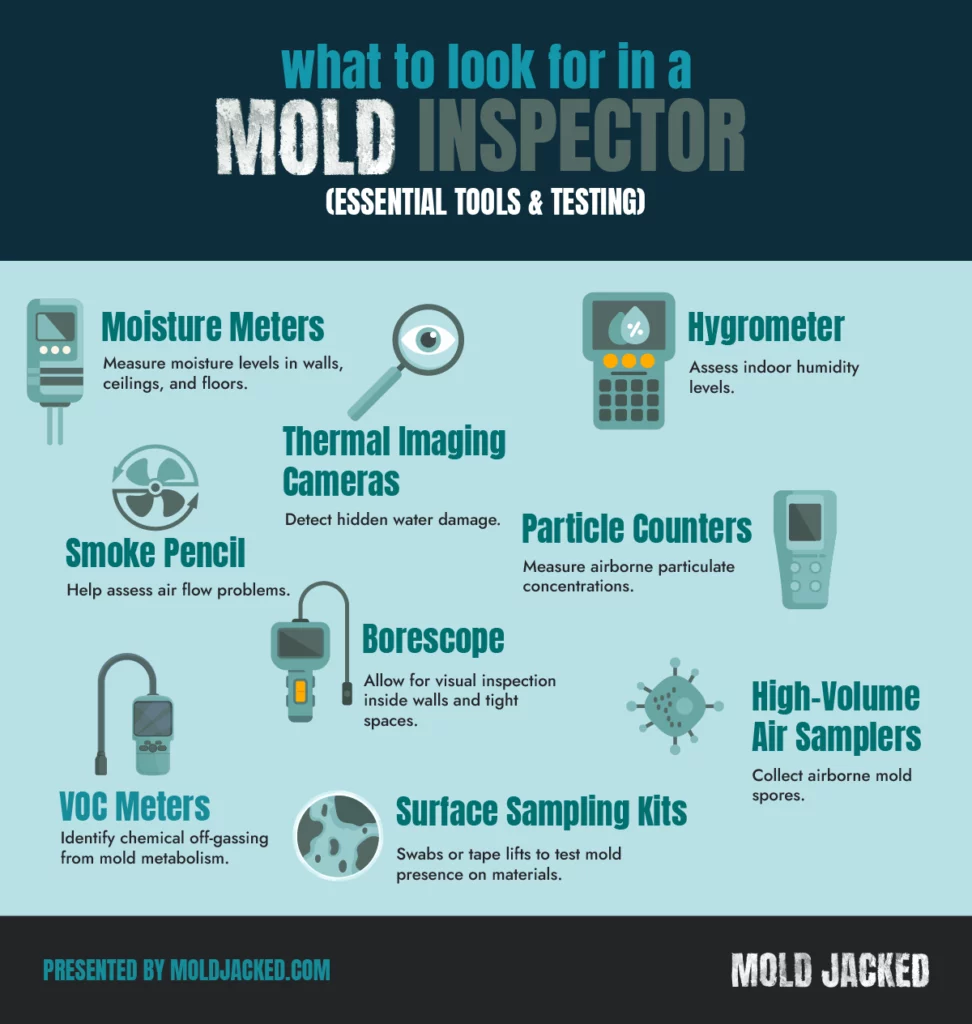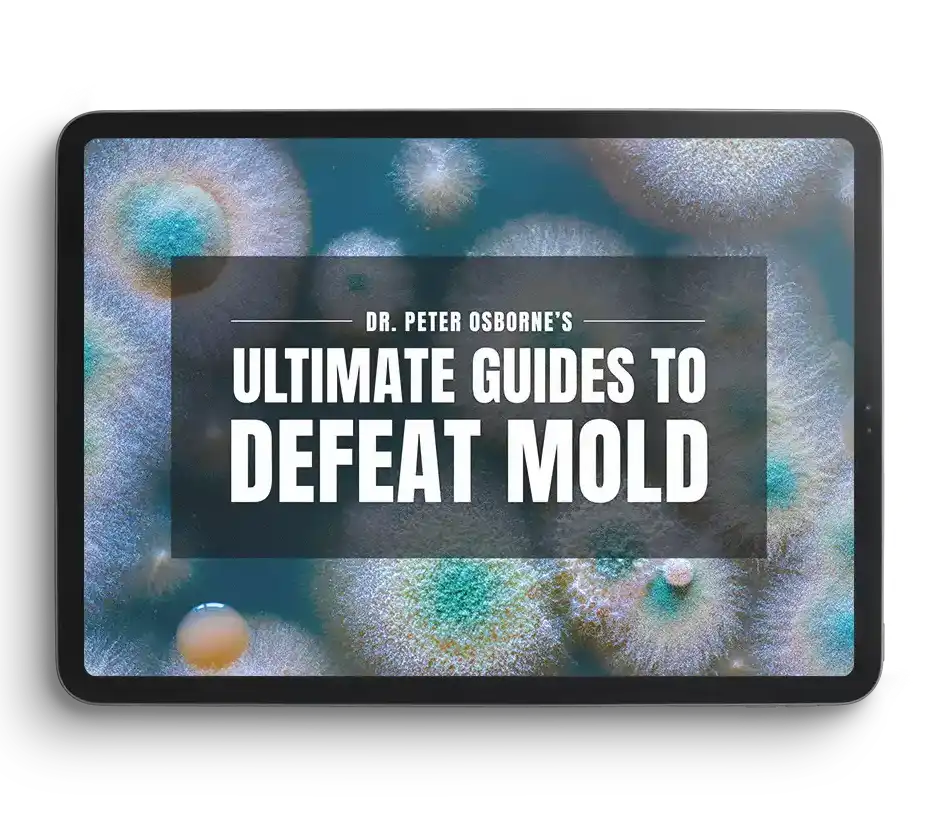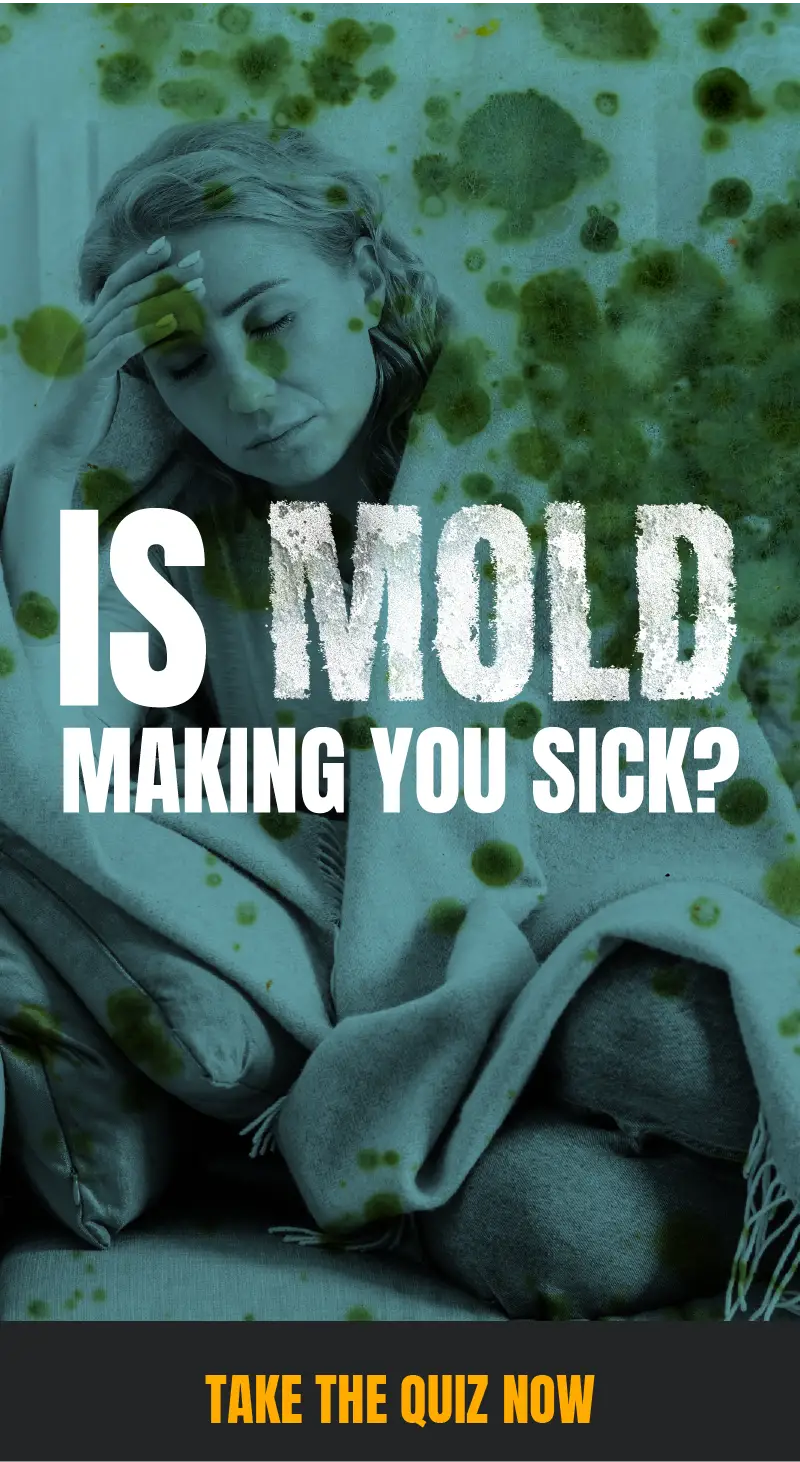Table of Contents
Introduction - How to Find a Qualified Mold Inspector
If you suspect that you have a mold issue in your home, read this entire article… twice. Don’t skip ahead. Read it line for line. It may save your life. That is not hyperbole. It may safe the life of your family members. It may save the life or your pets.
Mold contamination in homes poses significant health risks, including respiratory issues, neurological damage, immune system dysfunction, and even risk of death. That’s why finding an expert to do your inspection is so important. My team and I put together a comprehensive guide on how to find a qualified mold inspector so that you have the knowledge and confidence to hire a competent company that takes mold seriously.
Why This Guide?
Unfortunately, incompetence in the mold inspection industry is very common. Many mold inspectors are actually “mold testers”. They perform a cursory visual walk through of a home and take a couple of air samples to assess for mold spores. They don’t tell you that air testing is inaccurate and misleading. They assume your ignorance on the topic, and take advantage of you. You see, mold inspectors are financially incentivized to perform as many inspections as they can in a day. So instead of doing 2-3 thorough inspections in a day, they do as many as they can. Many mold inspectors don’t understand the dangerous health consequences caused by chronic mold exposure. Many don’t understand that it can maim and kill you. Many inspectors (depending on your state) have education standards that don’t adequately prepare them to be experts.
 How do I know all of this? My family and I were victims of shoddy mold inspection work. When my family was in mold, the initial inspector performed a very limited inspection, relying heavily on air testing for his assessment. His incompetence was not benign. The mold inspectors incompetence killed my sweet little Maggie. Maggie was our family dog, and before the mold, she was healthy and happy..
How do I know all of this? My family and I were victims of shoddy mold inspection work. When my family was in mold, the initial inspector performed a very limited inspection, relying heavily on air testing for his assessment. His incompetence was not benign. The mold inspectors incompetence killed my sweet little Maggie. Maggie was our family dog, and before the mold, she was healthy and happy..
The damage didn’t stop there. His incompetence also made my family very sick. My son suffered with severe intestinal pains and random bouts of body rashes. My wife developed severe fatigue, vision loss, brain fog, memory loss, and joint pain. She lost her ability to effectively communicate with me because she couldn’t recall basic words. Both my wife and son developed suicidal ideations. I developed gynecomastia (man boobs) and gained excessive fat around my waste. I developed a migrating arthritis, vision loss, and fatigue. My sleep was disrupted because I was waking up every 2 hours to go to pee. I was unable to exercise due to pain. There is no doubt in my mind, that my family would have died had we listened to the incompetent mold inspector and stayed in that home.
My family and I had to learn the hard way. You can learn from our story by knowing what differentiates a qualified mold inspector from a dangerous one. Let’s dive in.
Why Hire a Mold Inspector?
Finding a qualified mold inspector can make or break your ability rule in or rule out a mold problem in your home. There are three primary reasons to hire a mold inspector.
- The first is to find the mold. Unfortunately, mold growth is not always outwardly visible or obvious. Mold can grown under flooring, behind walls, in the HVAC ducts, under sinks, and many other hidden places. An qualified inspector understands this. A dangerous one doesn’t.
- Determine why the mold is growing – Mold requires three things to grow, a food source, oxygen, and moisture. Our homes provide the food source. Oxygen is a given. It’s the moisture that makes or breaks the issue. Many inspectors are under the impression that the moisture has to be substantial liquid water, i.e. a flood, broken pipe, or roof leak. In reality, moisture could simply constitute elevated humidity in the form of water vapor. This is why the term “dampness” is commonly used in reference to mold growth in homes. This is why controlling moisture is the #1 way to prevent mold and microbial growth in homes.
- Create a comprehensive remediation plan to resolve the issue – Should remediation be necessary, the mold inspector creates the plan for you to hand over to an unaffiliated remediation company. Once the work is complete, the mold inspector should assess the remediation work to ensure it was done well and based on the formal remediation plan. This is done to protect the homeowner from poor work and to prevent conflicts of interest.
What Constitutes a Comprehensive Mold Assessment?
A proper mold inspection should be a thorough, science-based assessment of your home’s indoor environment. Unqualified inspectors often rely solely on air testing, which is insufficient. A comprehensive investigation is needed to detect all mold growth and its moisture sources. Without it, your family’s health could be at risk.
The following are essential elements to consider to ensure a comprehensive inspection is performed:
- Initial Consultation & Health History
- The inspector should inquire about the home occupants’ health symptoms, past water damage incidents, and any musty odors.
- Gathering a comprehensive history of the home’s maintenance, past repairs, and any known plumbing or roofing issues.
- Discussion of potential hidden mold sources, such as unvented bathrooms, basements, and improperly installed vapor barriers.
- Visual Inspection
- A thorough walkthrough to look for visible mold growth, water stains, peeling paint, warped materials, and condensation issues should be performed.
- Inspection behind walls, under flooring, inside HVAC systems, and in crawl spaces..
- Checking for improper construction or ventilation that could contribute to mold problems, including roof leaks, attic ridge vents, inadequate attic insulation, and foundation cracks.
- Evaluating windows, doors, and exterior cladding for signs of water intrusion.
- Moisture Mapping & Source Identification
- Identification of potential water intrusion sources such as leaks, poor drainage, and humidity problems.
- Thermal imaging cameras can detect temperature differences that indicate hidden moisture.
- The use of moisture meters to assess water content in walls, ceilings, flooring, and cabinetry.
- Assessing relative humidity levels throughout the home and pinpointing areas with excessive moisture.
- Inspecting exterior landscaping and drainage systems to determine if they contribute to indoor moisture issues.
- Air and Surface Sampling
- Air Sampling: Spore trap sampling of rooms as well as wall cavities. ***Air testing should always be performed by “disturbing” the room to emulate normal living conditions. Make sure you ask your inspector about this.
- Surface Sampling: Tape lifts or swabs to confirm the presence of mold species.
- Dust Sampling: ERMI testing to identify historical mold exposure.
- Evaluating mold load in different rooms to identify areas of high contamination.
- Ensuring proper laboratory analysis with chain-of-custody procedures to maintain sample integrity.
- HVAC System Inspection
- Mold-contaminated HVAC systems can spread spores throughout a home. The inspector should evaluate ductwork, coils, and filters.
- Checking for microbial growth in air handlers and condensation pans.
- Evaluating the presence of particulate buildup, dust, or organic material that could serve as a breeding ground for mold.
- Assessing ventilation efficiency and air exchange rates to determine whether stale, humid air is contributing to mold issues.
- Documentation & Reporting
- A detailed report including photos, lab results, moisture readings, and recommendations for remediation and prevention.
- A breakdown of findings with an easy-to-understand summary and actionable recommendations.
- Explanation of test results, including mold species detected and their potential health impacts.
- A comprehensive assessment of remediation needs, including whether professional intervention is necessary or if minor corrections can resolve the issue.
- Post-Remediation Verification (if applicable)
- A follow-up inspection to confirm that remediation was successful and air quality has improved.
- Repeating air and surface sampling as necessary to verify clearance levels.
- Ensuring that root causes (leaks, ventilation issues) have been fully addressed to prevent recurrence.
- Educating homeowners on best practices for maintaining a mold-free environment, such as controlling humidity and proper HVAC maintenance.
Essential Tools and Testing Methods
A mold inspector needs specialized tools to conduct a thorough and accurate evaluation of a home’s indoor environment. Moisture meters are essential for detecting elevated moisture levels in walls, ceilings, and floors—critical areas where mold thrives. Thermal imaging cameras enhance this process by identifying hidden water damage that may not be visible to the naked eye. Hygrometers provide insight into indoor humidity levels, as excessive moisture in the air can contribute to mold growth. Smoke pencils are used to assess airflow patterns. This can indicate how mold spores and moisture travel within a building.
To evaluate airborne contaminants, particle counters measure the concentration of particulates in the air, offering clues about mold presence and air quality. High-volume air samplers collect airborne mold spores for laboratory analysis, helping determine the severity of an infestation. Meanwhile, surface sampling kits, such as swabs or tape lifts, allow for direct testing of suspected mold growth on materials. Borescopes enable inspectors to visually inspect inside walls and tight spaces without causing unnecessary damage. VOC meters detect volatile organic compounds released by mold metabolism, providing additional evidence of hidden mold. Finally, DNA-based testing (MSQPCR) offers precise identification of mold species and quantifies levels in settled dust, giving a more comprehensive understanding of contamination. Using these tools together ensures a complete and science-backed mold assessment. Which in the end helps identify problems accurately and guide effective remediation. The following checklist should help you find a qualified mold inspector. When interviewing companies, ask if they use the following tools as a regular part of their inspections.
- Moisture Meters: Measure moisture levels in walls, ceilings, and floors.
- Thermal Imaging Cameras: Detect hidden water damage.
- Hygrometers: Assess indoor humidity levels.
- Smoke Pencils: Help assess air flow problems
- Particle Counters: Measure airborne particulate concentrations.
- Borescopes: Allow for visual inspection inside walls and tight spaces.
- High-Volume Air Samplers: Collect airborne mold spores.
- Surface Sampling Kits: Swabs or tape lifts to test mold presence on materials.
- VOC Meters: Identify chemical off-gassing from mold metabolism.
- DNA-Based Testing (MSQPCR): Evaluate mold species and levels in settled dust.
Warnings and Red Flags When Hiring a Mold Inspector
- Conflict of Interest
- Avoid companies that offer both inspection and remediation services, as they may exaggerate mold problems to sell their services.
- Lack of Proper Certification
- Ensure the inspector has certifications from organizations like:
- American Council for Accredited Certification (ACAC)
- National Organization of Remediators and Microbial Inspectors (NORMI)
- Institute of Inspection Cleaning and Restoration Certification (IIRC)
- National Association of Mold Professionals (NAMP)
- Indoor Air Quality Association (IAQA)
- International Society of Indoor Air Quality and Climate (ISIAQ)
- Ensure the inspector has certifications from organizations like:
- Reliance Solely on Air Sampling
- Air sampling should not be the only method used, as mold spores fluctuate and can be misleading.
- Failure to Perform Moisture Testing
- A thorough inspection includes moisture readings to identify the root cause of mold growth.
- No Written Report
- A credible inspector provides a detailed, science-backed report with findings and recommendations.
- Use of Unverified Testing Methods
- The inspector should use standardized, validated laboratory testing methods rather than DIY or unapproved techniques.
- Minimizing or Dismissing Health Effects
- An inspector should acknowledge the health risks of mold exposure, especially for individuals with respiratory issues, allergies, or immune disorders.
- Unwillingness to Explain Findings
- A reputable inspector should be able to clearly explain results, reports, and remediation recommendations.
- No Insurance or Liability Coverage
- Ensure the inspector carries Errors & Omissions (E&O) and general liability insurance to protect consumers.
- Rushed Inspections
- A thorough mold assessment takes time; be cautious of inspectors who provide quick, superficial evaluations.
- Lack of References or Customer Reviews
- Avoid inspectors who cannot provide references or have poor reviews from previous clients.
How to Choose the Right Mold Inspector
- Check Credentials & Certifications: Ensure they hold industry-recognized certifications.
- Ask for References & Reviews: Look for client testimonials and case studies.
- Inquire About Testing Methods: Confirm they use multiple, reliable testing strategies.
- Request a Sample Report: A professional should provide a sample of their reporting format.
- Compare Costs & Services: Price should reflect a comprehensive assessment, not just basic air sampling.
Frequently Asked Questions (FAQ)
1. How do I know if I need a mold inspection?
If you experience persistent health issues such as respiratory problems, headaches, fatigue, or allergies, or if you notice musty odors or visible mold growth, a mold inspection is recommended. Additionally, if your home has experienced water damage, leaks, or high humidity levels, an inspection can help identify hidden mold issues.
2. What qualifications should a mold inspector have?
A qualified mold inspector should have certifications from reputable organizations such as the American Council for Accredited Certification (ACAC), the National Organization of Remediators and Microbial Inspectors (NORMI), the National Association of Mold Professionals (NAMP), or the Indoor Air Quality Association (IAQA). They should also have experience in building science, moisture intrusion, and microbiology.
3. How much does a mold inspection typically cost?
The cost of a mold inspection varies depending on the size of the property, the complexity of the inspection, and the types of tests performed. A thorough inspection can range from $1,000 to $2,000. Additional testing, such as air and surface sampling, may increase costs.
4. Is air sampling necessary for a mold inspection?
Air sampling can be useful in cases where hidden mold is suspected (especially samples taken from wall cavities), but it should not be the sole method of assessment. A thorough mold inspection includes a visual assessment, moisture mapping, and surface sampling when appropriate.
5. Can I perform a mold inspection myself?
While DIY mold test kits are available, they are often unreliable and do not provide comprehensive information about mold presence and sources. While they are sometimes helpful as general screening tools, it is not recommended that you rely on these tests if you suspect mold is a problem in your home. A professional mold inspector has specialized equipment and expertise to conduct a thorough evaluation and identify the root cause of mold growth. That being said, you should take an active role in learning how to identify potential signs of a mold problem in your home. You can learn more about this in our comprehensive guide on How to avoid renting or buying a moldy home.
6. What should I do if my home tests positive for mold?
If mold is detected, the next steps depend on the severity of the issue. Small, localized mold problems may be managed with proper cleaning and moisture control. However, significant mold contamination requires professional remediation. Addressing the source of moisture is essential to prevent future mold growth.
7. How long does a mold inspection take?
A mold inspection typically takes 2 to 5 hours, depending on the size of the property and the complexity of the inspection. If extensive sampling is required, it may take longer.
8. What is the difference between mold inspection and mold remediation?
Mold inspection involves assessing a property for mold presence, identifying sources of moisture, and recommending remediation steps. Mold remediation is the process of removing mold contamination and preventing its recurrence. It is crucial to hire separate companies for inspection and remediation to avoid conflicts of interest. You can read our consumers guide to mold remediation here.
9. Can mold make me sick?
Yes, mold exposure can cause various serious health issues, including respiratory problems, skin inflammation, nerve damage, headaches, fatigue, and immune system dysfunction. Read more about the impact of mold exposure on health including symptoms and disease relationships here.
10. How can I prevent mold growth in my home?
To prevent mold growth, control indoor humidity levels (ideally below 50%), ensure proper ventilation, fix leaks promptly, and use dehumidifiers in damp areas. Regularly inspect your home for signs of water damage and address any issues immediately. You can learn more about mold prevention in our comprehensive guide.
Conclusion -How to Find a Qualified Mold Inspector
Finding a qualified mold inspector is a crucial step in ensuring the health and safety of your home environment. A thorough assessment requires a combination of visual inspection, moisture testing, air and surface sampling, and comprehensive reporting. Avoid inspectors with conflicts of interest, and ensure they use proper scientific methodologies. By following this guide, consumers can make informed decisions and effectively address mold problems in their homes.



